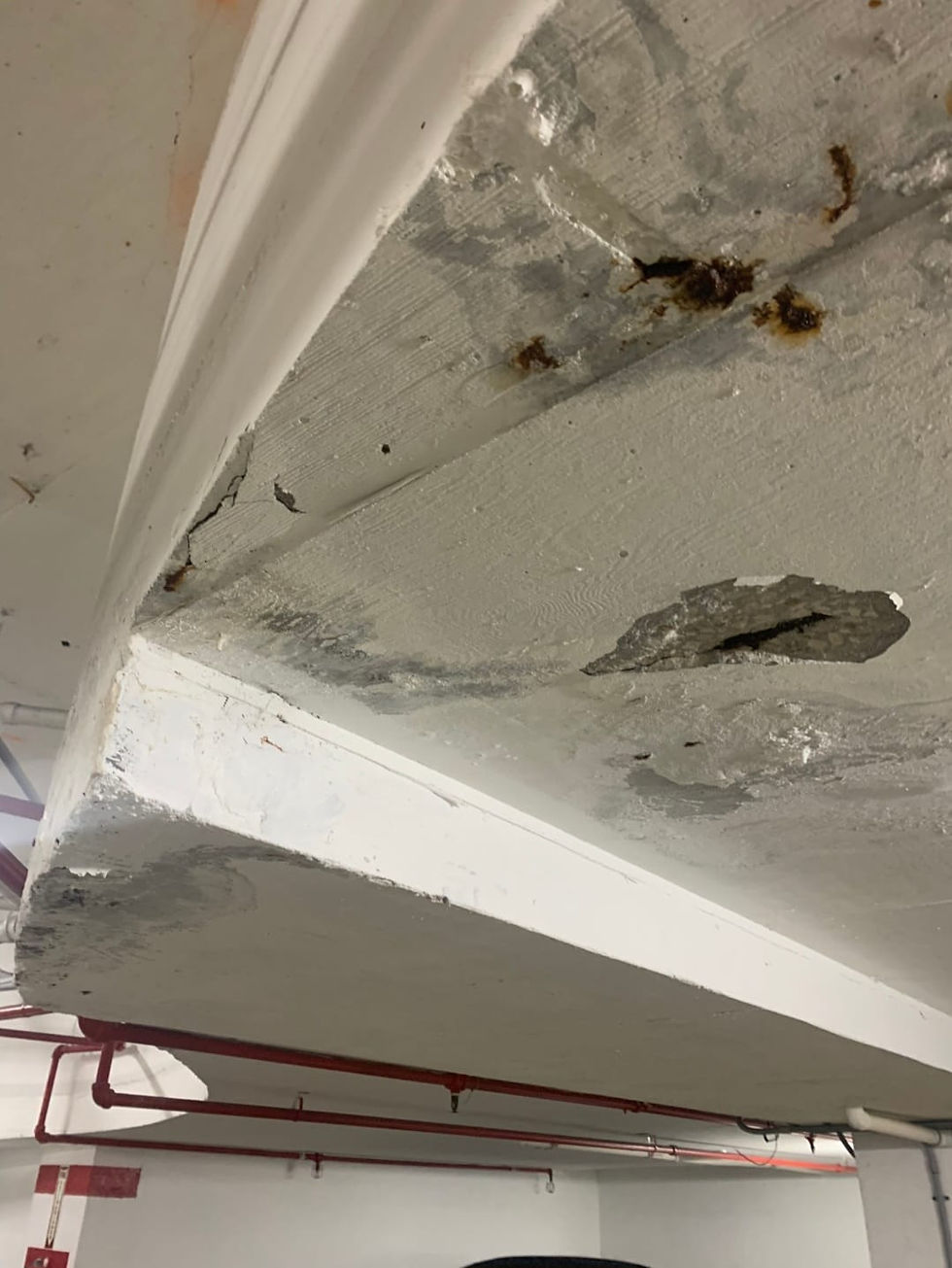6 Signs Your Condo Needs a Structural Inspection Before Building Recertification
- Hanny Gomez

- Aug 4
- 4 min read
Avoid costly surprises—how Florida condo managers can detect structural problems before structural inspection.

Most property managers wait for the official 30-, 40-, or 50-year recertification deadline before bringing in engineers to assess their building’s structure. But truth be told, many structural issues start developing years earlier—and ignoring early warning signs can cost you a fortune later.
Here’s what you really need to know: Buildings “talk.” Cracks, leaks, rust, and visible damage are all signs that your structure may be compromised—even if you’re still years away from a mandatory inspection.
This guide walks you through six clear signs that your building may need a structural inspection now, not later.
1. Cracks in Beams, Ceilings, or Columns
Not all cracks are dangerous, but some are major red flags. As a property manager, it’s important to differentiate between harmless settlement cracks and those that indicate structural stress or movement.
Be on the lookout for:
Diagonal cracks around door or window frames
Step cracks in concrete block walls
Cracks that widen over time
Gaps between columns and the slab
If you're seeing any of these patterns, it may mean your building is shifting—or worse, that internal reinforcement is failing.
👉 Pro tip: Take dated photos to monitor progression. If cracks are growing or new ones appear, it's time to call an engineer.
2. Persistent Water Intrusion or Failed Sealants
Water damage is more than an annoyance—it’s a structural threat. When water infiltrates a building repeatedly, it can corrode the reinforcing steel (rebar) embedded in the concrete. This corrosion expands and causes the concrete to crack from the inside out.
Common signs include:
Water stains or discoloration on ceilings or walls
Peeling paint or bubbling on surfaces
Musty odors in basements or common areas
Leaks that keep returning, even after repairs
👉 Action step: Don’t settle for patching the leak. Hire a professional to determine whether structural components have been compromised due to ongoing moisture.
3. Balconies or Railings That Shift, Rust, or Feel Unstable
Balconies and walkways take a lot of abuse from weather and foot traffic—especially in Florida's coastal climate. Over time, that exposure leads to corrosion, instability, and concrete weakening.
Warning signs:
Rusted base plates or anchors on balcony railings
Crumbling concrete at edges or corners
Movement or “give” when walking on elevated walkways
Loose or rattling railings
Beyond the safety risk, these signs may mean that steel reinforcements inside the concrete are deteriorating.
👉 Don't wait: Unstable balconies are one of the top safety hazards in multifamily buildings and should be inspected immediately.
4. Visible Rust on Exposed Structural Steel
Rust isn’t just an eyesore. When you see rust on exposed beams, staircases, or parking structures, chances are there’s more corrosion you can’t see—like inside your concrete slabs or support columns.
Key areas to check:
Steel beams exposed to weather
Rooftop equipment supports
Metal staircases and landings
Parking garages with steel structures
If rust is flaking, scaling, or eating through paint, it's already advanced.
👉 Inspection tip: Surface rust might be fixable, but deep corrosion requires expert evaluation. Structural steel plays a critical role in your building's stability.
5. Outdated or Missing Inspection Records
You’d be surprised how many buildings lack up-to-date inspection reports. If your building hasn’t had a structural inspection in the last 10 years—or you don’t even know when the last one was—you’re flying blind.
Warning signs:
No signed engineering reports on file
No maintenance logs for structural elements
No digital archive of previous restoration work
This isn’t just a paperwork issue. It puts your HOA or management company at risk when city inspectors eventually come calling.
👉 Best practice: Schedule a proactive inspection every 5–7 years, even if your recertification deadline is still a decade away.
6. Visible Concrete Damage – Especially in Slabs
If you can see chunks of concrete missing, crumbling, or hanging loose, you’ve got a problem.
This type of damage—known as spalling—happens when water gets into the concrete and corrodes the rebar inside. The expanding steel pushes outward, causing the concrete to crack and break apart.
This is particularly dangerous when it occurs in overhead slabs, such as parking garages, balconies, or walkways.
Look for:
Exposed steel rebar
Loose or falling pieces of concrete
Hollow-sounding areas when tapped
Brown stains or rust leaching from cracks
👉 Safety concern: These damaged sections can fall and cause injury to residents, visitors, or damage to vehicles. If you can see it, don’t ignore it—have it inspected immediately.
🔍 What Makes These Signs So Important?
These aren’t just cosmetic issues. Each one could be a sign that the integrity of your building is at risk. And if left unaddressed, they will eventually show up during your recertification process—when it’s more expensive and urgent to fix.
Taking action before you’re legally required to can save your HOA thousands of dollars in emergency repairs, lawsuits, or fines. Plus, it gives your residents peace of mind.
🛠️ How BRS Florida Can Help
At BRS Florida, we specialize in guiding property managers and condo boards through building recertifications and restorations. But more importantly—we help you stay ahead of the process.
We’re not contractors. We’re Owner’s Representatives who work solely in your best interest. From coordinating inspections to reviewing proposals and overseeing repairs, we’re with you every step of the way.
✅ 25+ years of experience
📑 Real-time tracking tools for your board
🛡️ Independent project management—no contractor bias
📩 Don’t Wait for the City to Tell You It’s Time
If your building shows any of the signs we’ve listed above, let’s talk. We offer free consultations and a downloadable Structural Evaluation Checklist to help you get started.
👉 Visit brsflorida.com to schedule your review or grab the checklist.




Comments